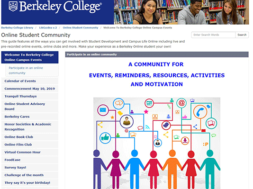
Connectivism in Distant Education
By Dr. Jay M. Keehn, Executive Director, Florida Academic Center/System, Director, Student Success/ADA Coordinator, Union Institute & University
Introduction
Community.
There may be several images conjured up when one hears this word. It may bring you to a place where people run into each other at the supermarket or place of worship. It may stir warmer feelings of neighbors helping neighbors during times of personal (family death) or communal (natural disaster) crisis. Or, it may lend to a more metaphysical definition, whereby groups of individuals gather for emotional support or needed motivation. A more modern response may include the impact that the tsunami of technological advancements has had on community.
In 1968, Licklider & Taylor wrote: “What will online interactive communities be like? In most fields, they will consist of geographically separated members, sometimes grouped in small clusters and sometimes working individually. They will be communities not of common location, but of common interest. You will not send a letter or a telegram; you will simply identify the people whose files should be linked to yours.”
In 1968, most people would only have thought of a community involving those they can physically be with.
If you wanted to be part of a community of people watching baseball together, then you needed to be within driving distance of others who watch baseball to be part of said community. But, Licklider & Taylor obviously envisioned a totally different community, as they headed the government project called ARPAnet (predecessor to the internet). They saw how technology can impact community. Thus, began the shift from, as they say, common location to common interest.
Until recently, this shift may have seemed to be occurring at a turtle’s pace. In 1987, Rheingold became the first to coin the term “virtual community.” He wrote: “A virtual community is a group of people who may or may not meet one another face-to-face, and who exchange words and ideas through mediation of computer bulletin boards and networks.”
We had begun seeing more computer use for communication purposes. It was not the mass two-way communication we have become familiar with in recent years. There were computer bulletin boards where people would post information, but would not know if anyone viewed the post, and further, if anyone would reply to the post. At this point in history, while community was becoming more virtual, it was still one-way communication.
In 2005, Downes defined community as: “A place in which we have learning experiences, and the environment through which we communicate with each other about these experiences.” In this modern definition of community, there is no reference to face-to-face interaction. You no longer need to be within distance of school, library, etc. to be part of a community. Using technology as a bridge, the internet has evolved from information storage to a significant social platform.
Connectivism
This evolution became the ignition that drove the development of the new learning theory called “Connectivism.” Over the last 20 years, technology has reorganized how we live, how we communicate, and how we learn (Siemens, 2005). Consequently, the definition of community today has expanded limitlessly to any group of individuals with something in common. This could even include registered students in a common online course. As Block stated (2008): “We are a community each time we find a place where we belong. To belong is to be related to and a part of something.”
Now, you can belong to anything, with anybody, anywhere. Now, you can log on to any social media platform, join a virtual community watching baseball games together, share fanatical opinions, and even upload photos of the snacks that you are enjoying, despite potentially thousands of geographical miles between each group member. New technologies that influence how information is created and shared allows for new definitions of community and education that includes social networking and user-friendly publishing tools that increase engagement in online conversations (Siemens & Conole, 2011). As a result, learning, academic interaction, and pedagogy has completely been altered.
According to Connectivism theory, learning can reside outside of ourselves. It is focused on connecting specialized information sets, and the connections that enable us to learn are more important than our current state of knowing.
Connectivism is driven by the understanding that decisions are based on rapidly altering foundations.
New information is continually being acquired. The ability to draw distinctions between important and unimportant information is vital. The ability to recognize when new information alters the landscape based on decisions made yesterday is also critical (Siemens, 2005).
Connectivism was born from the idea that the learner is at the center, connecting and constructing knowledge in a context that includes not only external networks, but also the individual’s own history and partialities (Anderson & Dron, 2011). The ability to now connect to any conceivable resource changes the manner in which one acquires knowledge both inside and outside of the classroom, and further significantly reworks the way in which an individual may present themselves to others. Learning is now networked where the connections are many-to-many and where they might run in any direction between the participants and the resources related to learning (Kop, 2011). Technology is the bridge that transports people from a world of communication limited by physical presence to a new world unobstructed by geographic boundaries.
The theory of Connectivism provides a useful lens to interpret how individuals access and interact with experts from within their professional discipline in multiple and far-reaching locations (Mackey & Evans, 2011). It is not simply a technique for improving individual educational outcomes, but rather seeks to build communities and collective capacities for learning (Ito, et. al. 2013). It is driven by the understanding that learning is the act of determining what is important versus what is not from within a broad range of rapidly changing information (Siemens, 2005), and that which arises out of interaction between a large number of people and informational assets (Williams, Karousou, & Mackness, 2011). While people connect through communities of learners that are supported by today’s technology (Nussbaum-Beach & Ritter-Hall, 2012), the capability to discriminate between significant and insignificant information becomes considerably more critical.
While in 1968, a community could only have been relatively small, today’s communities can be purposefully small or infinitely large. If you wish to have an online community consisting of just single women who enjoy listening to jazz music, you can. As stated, community is now built on common interest, not geography. In essence, Connectivism proposes teaching strategies without formal teaching dynamics that allow the educator to have the role of facilitator (Siemens & Downes, 2009). This notion completely embraces the concept of educator as guide on the side, rather than sage on the stage. Consequently, there has also been a shift in distant education.
Distant education
Over 6.4 million students were taking at least one online course in 2017, which is 32 percent of all higher education students (Seaman, Allen & Seamen, 2018). Seventeen percent of all students are in a fully online college program. The elite, pace-setting universities now embrace the internet, and online activity is at the core of how these schools envision their futures (Brooks, 2012).
Distant education has evolved from the practice more commonly known as correspondence education, whereby instructor and student would correspond through snail mail. In those days, a student would receive a syllabus with readings and assignments from the professor. Then, once completed, the student would send back the required documentation, and then the professor would mail back feedback, and so forth. Television and radio were once an educational tool for instructors to broadcast their lectures to students in various locations. Distant education moved with the times using fax machines, emails, and website templates as methods for teaching and learning.
There has been a substantial conversion in online education since the initial templates.
Due to the increased sophistication of technology, what appeared to be “bells and whistles” actually have transformed online learning by providing parallel experiences available in a traditional face-to-face classroom, and a new pathway for critical reflection.
This is exemplified in online courses which may include video streaming, PowerPoint presentations, article downloads, threaded discussions, etc. Online education offers the convenience of not having to confine yourself to a classroom and the flexibility to learn on your own time. Thus, online education may provide a more feasible option as it offers both synchronous and asynchronous learning conditions.
Distance learning can expand access to education. For universities, devolving some activities off-site alleviates constraints arising from the traditional economic demand on institutional infrastructure. Furthermore, universities may gain increased access to more experts in the field to employ as adjuncts. Distance education programs can act as a catalyst for innovation and, due to the aforementioned parallels to face-to-face learning, have been effective in meeting academic outcomes.
Distance education can also provide a broader method of communication within the realm of education. The increase in communication is an improvement that has been made to provide students with as many of the opportunities as possible as they would receive in the traditional learning environment. Similar to the traditional students meeting in the classroom at a set time each week, the online students meet through technology to discuss requisite content relevant to the course. This is academic communication in their virtual community.
Connectivism in distant education
Social networks are virtual communities for people to share their daily activities and particular topics of interest with family and friends, as well as increase their circle of acquaintances, to include, for instance, new classmates. It is ongoing and continuous. The dialogue continues regardless of whether or not you are logged on to the online community. Further, while one is offline, the connection points on the platform continue to expand. You do not always need to be present to be part of the community. And, the community can now become massive. There is an innovative aptitude to share resources with a large number of people.
This has expanded education. Specifically, this has changed the role of the instructor from, as mentioned, sage on the stage to guide on the side. With the entry point being the student, Connectivism’s impact on education suggests a contrary teaching strategy which encourages the instructor to now be more of a facilitator.
Learning, in this new milieu, mirrors a connect-the-dots puzzle. Each dot is part of a complex disarray of ideas. The accumulation of dots represents vast information floating in the virtual universe, or, as previously stated, specialized information sets. One is unsure exactly how all fits together until the dots are connected. Knowledge that resides in a database needs to be connected to the right people in the right context in order for all the dots to be accurately connected and for learning to occur (Siemens, 2005). Each time one dot is connected to the next, the person becomes closer to understanding what the completed picture should look like. Every time an individual makes a connection to another individual or a resource that resides outside of one’s self (i.e., links posted by an online course facilitator), they have the possibility to reach a completely new understanding of a given concept. The focus on active participation is most suitable here as this type of learning encompasses the dynamic engagement of many people through the sharing of key resources (Kop, 2011). As stated, it is now vitally important to ascertain what is needed information to connect the dots, and what is not. Connection making is the learning activity.
How one may get from point “A” to point “B” is more imperative than the actual content at point “A” and point “B.”
As Connectivism theory stipulates, the pipes are more important than what is in the pipes. Distant education must use all touch points and appropriate technology to create a sense of belonging for individuals with something in common. That something can simply be that each individual is a member of the same online course.
Therefore, it is the responsibility of the educator to ensure that the connections are plentiful in the online course. This includes, but not limited to, peers, advisors, information technology department, library resources, support services, career guidance, residence life, local community agencies and businesses, etc. Further, the methodologies for connection making need to be a vast collection. This includes, but not limited to, links on the LMS site, WhatsApp, YouTube, LinkedIn, Facebook, Twitter, live or virtual office hours, etc. Each of these leads to new learning via connections. Each is a different size, shape, or color pipe creating information and knowledge for the common goal – success in the course and beyond. And, each student may need a different pipe to get to that common goal.
One may think that in online education, the focus on the student is diminished. How can you focus on the student if you do not see them face-to-face? Connectivism theory flips that. The starting point is the student. This is why the new definition of community, especially as it relates to higher education, must include a sense of belonging. A student’s community in 1968 was only within the boundaries of what was accessible on campus. In 2019, a student’s academic community has to be limitless.
Conclusion
The complements of technological enhancements has significantly impacted the texture of the sociology of education. As evidenced throughout this scripture, there is a perpendicular convergence of the change in the definition of community and the delivery methodology within education.
The emphasis on common interests has caught up and even surpassed that of common location. As such, the images that are conjured up when one hears the word community is now vastly different. Now, that definition may actually refer to belonging to any group of individuals with something in common.
As demonstrated, that something in common may be similar educational goals or career paths. Connectivism theory has come along to wrangle in the new normal in learning. Its’ focus on the student, transition of faculty to facilitator, and connection making as an academic endeavor, has painted the landscape with its technological tentacles at the forefront. In this manner, it is apparent why distance education, with its enormous rise in popularity, must recognize the social impact that has been created.
Sociologically, technology has become a bridge for community development and maintenance. Therefore, educationally, technology also has to be employed for community development and ultimately academic and future successes.
References
Anderson, T., & Dron, J. (2011). Three generations of distance education pedagogy. International Review of Research in Open and Distance Learning 12(3), 80 – 97.
Block, P. (2008). Community: The Structure of Belonging. San Francisco, CA. Berrett-Koehler Publishers.
Brooks, D. (2012, May 3). The campus tsunami. The New York Times.
Downes, S. (2005). Community Blogging. Retrieved from https://www.downes.ca/index.html on October 10, 2019.
Ito, M., Gutiérrez, K., Livingstone, S., Penuel, B., Rhodes, J., Salen, K., Schor, J., Sefton-Green, J., & Watkins, C. (2013). Connected learning: An agenda for research and design. Irvine, CA: Digital Media and Learning Research Hub.
Kop, R. (2011). The challenges to connectivist learning on open online networks: Learning experiences during a massive open online course. International Review of Research in Open and Distance Learning 12(3): 19 – 38.
Licklider, J.C.R. & Taylor, R. (1968). The computer as communication device. Science and Technology, 61: 21 – 41.
Mackey, J., & Evans, T. (2011). Interconnecting networks of practice for professional learning. International Review of Research in Open and Distance Learning 12(3), 1 – 18.
Nussbaum-Beach, S., & Ritter-Hall, L. (2012). The connected educator: Learning and leading in a digital age. Bloomington, IN. Solution Tree Press.
Rheingold, H. (1987). Virtual communities. Whole Earth Review. 1(1), 1 – 5.
Seaman, J.E., Allen, I.E., & Seaman, J. (2018). Grade Increase: Tracking Distance Education in the United States. Babson Survey Research Group.
Siemens, G. (2005). Connectivism: A learning theory for the digital age. Instructional Technology and Distance Learning. 2(1).
Siemens, G., & Conole G. (2011). Connectivism: Design and delivery of social networked learning. International Review of Research in Open and Distance Learning. 12(3), i – iv.
Siemens, G., & Downes, S. (2009). Connectivism & Connective Knowledge. Retrieved from http://ltc.umanitoba.ca/connectivism/ (link is no longer active) on October 10, 2012.
Williams, R, Karousou, R.,& Mackness J. (2011). Emergent learning and learning ecologies in Web 2.0. International Review of Research in Open and Distance Learning, 12(3), 39 – 59.
DR. JAY M. KEEHN is the Executive Director for the Florida Academic Center of Union Institute & University, as well as Director of Student Success and ADA Coordinator for the University at large. Dr. Keehn oversees all academic, enrollment, and support operations in the state of Florida for the regionally accredited, national, not-for–profit university. Also, during his tenure at Union, he filled the roles of Faculty and Director of the Master’s of Education program, as well as Associate Dean for Student Success.
Dr. Keehn holds a Ph.D. in Educational Leadership with a specialization in Counseling, a M.Ed. in School Psychology, and a BA in Sociology. His career path includes providing services for students with disabilities at a community college, opening a charter school, functioning as director of education of a preschool for medically fragile children, and supervising mental health professional in a clinical setting. He has been with Union Institute & University for over 14 years.
Dr. Keehn’s research passion focuses on the sociology of education.
Contact Information: Dr. Jay M. Keehn // Executive Director, Florida Academic Center/System Director, Student Success/ADA Coordinator, Union Institute & University // 954-284-2140 // jay.keehn@myunion.edu // https://www.linkedin.com/in/jaykeehn/









